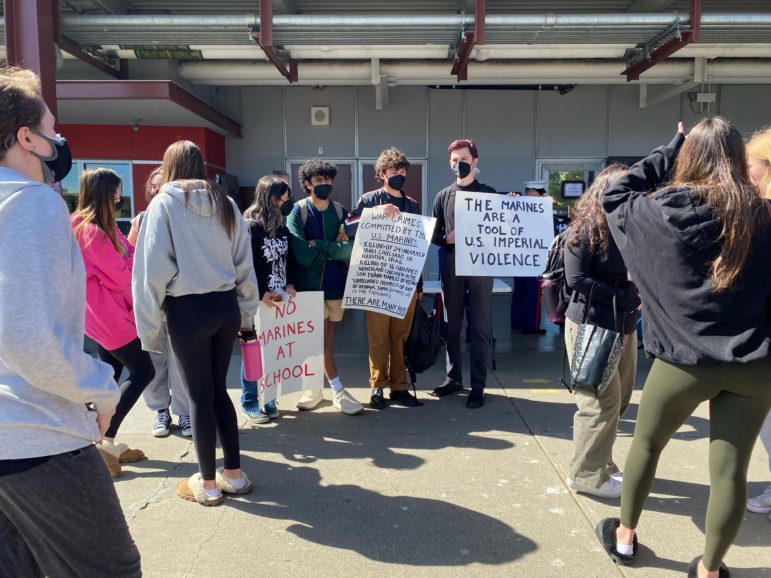

As the school year draws to a close, a booth draped in a military banner has become a regular presence in Center Court. The sight of uniform-clad soldiers handing out brochures receives a few passing glances. Students who visit the booth leave with new information on the military, business cards or miniature American flags.
“I go to schools to provide students the information they need to make an educated decision to see if the Marine Corps is the right path to pursue,” said Staff Sergeant Geddy Lee Lawas, who recruits for the Marines. “There is not a specific way to become successful in your life. There are multiple opportunities that will help you get yourself to where you want to be.”
Recently, the booths have attracted the attention not only of students who are looking for information, but of those who disagree with the military’s presence on campus.
“I saw a lot of my friends around [the booth],” said sophomore Roshi Khilani. “One of [them was] debating with the military contractors.”
Historically, military recruitment on high school campuses has garnered controversy.
“They promise [college] tuition to students who sign up or enroll in one of their programs,” said junior Lucas Imboden. “But that targets lower income people. They may get sent to an active war zone in order to get education, which doesn’t seem fair. The military should not be the only way in which some people can afford to pay for college, so we decided to stand with signs because they’re not challenged anywhere.”
By the The No Child Left Behind Act, all public schools must make their campus accessible to military recruiters. The San Mateo Union High School District can provide recruiters with students’ directory information, which includes contact information, interests, official activities and more. The only exception made is with a written statement from parents requesting exemption.
In front of an Army recruiter’s booth, Imboden and other students held a protest, holding signs with various messages. The theme was clear: “The military does not belong at school,” one sign read. The protests were met with varying degrees of responses.
“The first time, it was Marines and they were concerned about being photographed with our signs,” Imboden said. “They decided to pack up immediately. The second time we did it, it was with the Army and they were intent on staying there.”
Imboden also experienced mixed reactions from students and Aragon administrators.
“The military should not be the only way in which some people can afford to pay for college”
“A fairly sizable group of students gathered around to kind of jeer at us and there were people shouting, ‘Let’s go military,’” Imboden said. “Because there was such a large crowd of people yelling at us, there was an administrator who stayed with us. [The administration] hasn’t said [they] support [our] message, but they haven’t gotten in our way.”
Imboden also provided insight on why he thought the protest faced backlash.
“I would definitely say there are more people against us than there are for us,” Imboden said. “I think there’s this [narrative] in America that the military is here to defend our freedom and it invades Iraq or numerous other countries in order to defend our freedom, so there’s this gut reaction when that’s challenged.”
Nearly 3% of graduating high school seniors enlist in the military immediately after graduation. High school students are a prime population for recruitment, hence the millions of dollars spent on the process.
“I do know a friend of mine who’s thinking of joining the military,” Khilani said. “He said he wants some education. They have … programs he wanted to check out, so he was thinking about it.”
Lawas sees the military as a pathway to more opportunities and as a support system to fund higher education.
“[My favorite part about being in the military is] the opportunities that the Marine Corps has provided for my wife, children and myself, [and] the financial security to ensure my family is well taken care of,” Lawas said. “I was afforded the opportunity to pursue my career as a V-22 Osprey [helicopter] mechanic and continue my education at the University of Arizona.”
Although he did not visit on the day of the protests, Lawas commented on the controversy in general.
“Continue to fight for what you believe in,” Lawas said. “It is everyone’s right to free speech. If you are willing to have a conversation with me, to discuss your concerns, I am open to discussion and I am open to expanding my perspective on why students feel the way they do.”
Khilani, like many students, remained an observer of both the protests and booths.
“I think there are some things I disagree with in the military,” Khilani said. “I did not participate in the protesting, but I thought it was a very interesting conversation.”
Military recruiters will be present next year in Center Court. As long as people remain engaged, whether as protestors, supporters or bystanders listening in, the conversation on military recruitment will stay alive at Aragon, and around the U.S.




